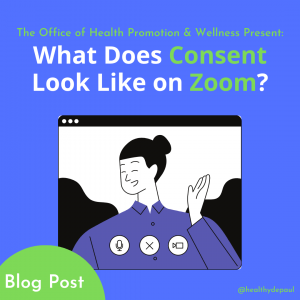‘Tis the season to be chatting about healthy relationships! If you’re familiar with our work in HPW you know that we talk about how relationships come in many forms and might look different for everyone. Something that you feel is a red flag in a relationship may only be a “yellow” flag for someone else. It’s important to really consider your own values and what you’re looking for in a relationship. Before you’re able to really establish good needs and boundaries with others you need to know yourself. A good relationship with ourselves is the most valuable relationship we can have; while a little bit of self-care can go a long way.
A key to sustaining healthy relationships with others is by setting boundaries and keeping open lines of communication. The earlier both of these can be established the better. These boundaries may be physical or emotional. If we’re talking about physical boundaries with others then it’s important to bring up consent as well. Consent is absolutely essential in all physical activity involving more than one person. If you’re speaking with a friend and observe your friend’s mood shift from good to bad you might ask if they want a hand to hold or a hug. This same principle applies to nearly all situations you come across. Whether it’s platonic, sexual, or anything in between, communication and consent still apply.
Never make assumptions about what a person needs at any given moment. Having poor boundaries gives room for others to make assumptions about another’s thoughts, feelings, and needs. As with any kind of relationship – it’s a system of give and takes. Take what you need and give what you can. But we need to be careful not to let others take too much from us or us to give too much to them. By defining good boundaries, you will set the expectations for what kind of behavior you will accept from others and what kind of behavior you want. Emotional boundaries refer to the ability to separate one’s feelings from the feelings of another. The best example I have for this is letting one person’s feelings dictate your own. If you think your boundaries are being crossed then it’s important to examine your own feelings toward that person. Do you seem irritated or resentful around them? Emotionally drained? Maybe it’s the other way around. This can lead to losing parts of yourself to them – or them to you. What might have been a small disagreement has suddenly turned into something much bigger because it’s possible that emotional boundaries may not have been set and/or adhered to. Co-workers, friends, or romantic partners – this applies to all of them.
Communicating our expectations in a relationship beforehand leaves far less room for interpretation and misunderstanding. It’s never too late to inform others of your boundaries, and it’s never too late to adjust your boundaries. Maybe you feel that you have more to give now that classwork seems lighter, or maybe it’s the opposite – and you have less to give because you’re buried in classwork. Either way, your boundaries should be expressed and must be respected. Make a commitment to put yourself first. We preach, “Take Care of Yourself” all day long and hopefully it’s easy to see why! If you find yourself struggling with your emotional health we have professional staff in the office who would be happy to give you advice, be a listening ear, or connect you with other on-campus or off-campus resources. Email us at “hpw@depaul.edu” or call by phone at (773) 325-7129. Check out our social media pages on Twitter, Facebook, and Instagram @healthydepaul. Blue Demons, don’t forget to Take Care of Yourself, Take Care of Others, and Take Care, DePaul!



